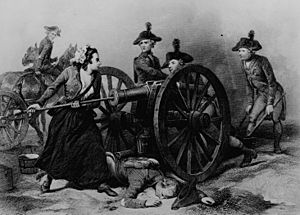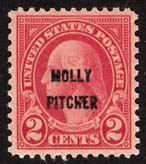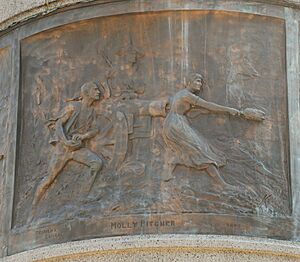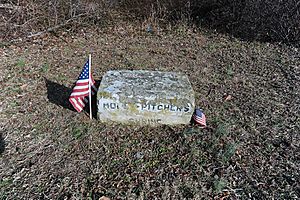Molly Pitcher facts for kids

Molly Pitcher is a famous legend from the American Revolutionary War. The story says she brought water to soldiers firing a cannon. When one soldier was hurt, she bravely took his place and fired the cannon herself.
Many historians believe "Molly Pitcher" was not one real person. They think it was a nickname for several brave women. These women helped soldiers during battles. Battles were often fought on very hot days. Soldiers needed water to drink and to cool their cannons. "Molly" was a common nickname for women back then.
Contents
The Story of Molly Pitcher
Stories about the American Revolution were first told by word of mouth. People would talk about them instead of writing them down. This meant storytellers could make things sound more exciting. Sometimes, they even made up parts that were not true. Some of these stories are still told today.
The legend of Molly Pitcher might come from several real women. Many women helped soldiers on the battlefields during the Revolutionary War. Most were wives or daughters of soldiers. The legend says Molly Pitcher brought water to a cannon crew. Her husband was one of the soldiers. When he was shot, Molly took his place. She helped fire the cannon. The Battle of Monmouth is likely where this legend began.
This story became popular many years after the war. Writers and artists helped share it. A famous picture of "Captain Molly" appeared in 1848. The first written story about Molly Pitcher was in 1859. By 1876, people started claiming a local woman was the real Molly Pitcher. From then on, the idea of Molly Pitcher grew very famous.
Today, Molly Pitcher is well-known. She is in grade-school and high-school textbooks. People even discuss if she was an early feminist.
Real Women Who Inspired the Legend
Most legends have some truth behind them. The story of Molly Pitcher is similar. Several women might have inspired the legend. Or, it could be a mix of all their stories:
- Mary Ludwig Hayes (also called Mary Ludwig Hayes McCauley) is in records from June 28, 1778. She signed up to serve with the Pennsylvania Artillery. She may have earned the nickname "Molly Pitcher." She brought drinking water to soldiers at the Battle of Monmouth. When her husband was hurt, Mary took his place at the cannon. The legend says George Washington thanked her. This might not be true. Pennsylvania later gave her a pension for her bravery.
- Margaret Corbin was with her husband at Fort Washington in New York City. When her husband John was wounded, she took his place at the cannon. She was hit by three cannon shots in her arm. The British captured her, but she returned to American care. Her arm never healed. She received a soldier's pension in 1779 for the rest of her life.
- Deborah Sampson was a tall woman. She dressed as a man and joined the 4th Massachusetts Regiment. Other soldiers called her "Molly" as a joke. She served for the rest of the war. Sampson was one of the few women to get a federal pension for military service.
During the Revolutionary War, it was not unusual for women to help in fights. Women took on many roles that people usually thought were only for men.
A Soldier's Account
Joseph Plumb Martin was a soldier in the Continental Army. He wrote about his experiences. Historians found his writings in the 1950s. Martin described a woman at the Battle of Monmouth:
A woman whose husband belonged to the Artillery, and who was then attached to a piece in the engagement, attended with her husband at the piece the whole time; while in the act of reaching a cartridge and having on of her feet as far before the other as she could step, a cannon shot from the enemy passed directly between her legs without doing any other damage than carrying away all the lower part of her petticoat,—looking at it with apparent unconcern, she observed, that it was lucky it did not pass a little higher, for in that case it might have carried away something else, and ended her and her occupation.
This account has been changed in other stories. Some say he gave her a name, but he did not.
How Molly Pitcher is Remembered
National Honors
In 1928, "Molly Pitcher" was honored on a United States postage stamp. The stamp had "MOLLY / PITCHER" printed on it. This was to celebrate 150 years since the Battle of Monmouth.
Later, in 1978, Molly was pictured on a postal card. This was for the 200th anniversary of the battle.
During World War II, a Liberty ship was named the SS Molly Pitcher. It was launched in 1943.
A part of US Route 11 in Pennsylvania is called the Molly Pitcher Highway.
The US Army has an honorary group called the Honorable Order of Molly Pitcher. It honors wives of artillerymen. It recognizes people who have greatly helped the Field Artillery community.
The U.S. Army base Fort Liberty has an event called "Molly Pitcher Day." It shows weapon systems and artillery to families.
Other Ways Molly Pitcher is Remembered
- The State of Tennessee has a license plate for women veterans. It shows Molly Pitcher.
- The Molly Pitcher Inn is a hotel in Red Bank, New Jersey. It is near the site of the Battle of Monmouth.
- The Molly Pitcher Service Area is a rest area on the New Jersey Turnpike.
- The Molly Pitcher Stakes is a horse race. It happens every year at Monmouth Park in Oceanport, New Jersey.
- The Molly Pitcher Brewing Company is in Carlisle, Pennsylvania.
Images for kids





